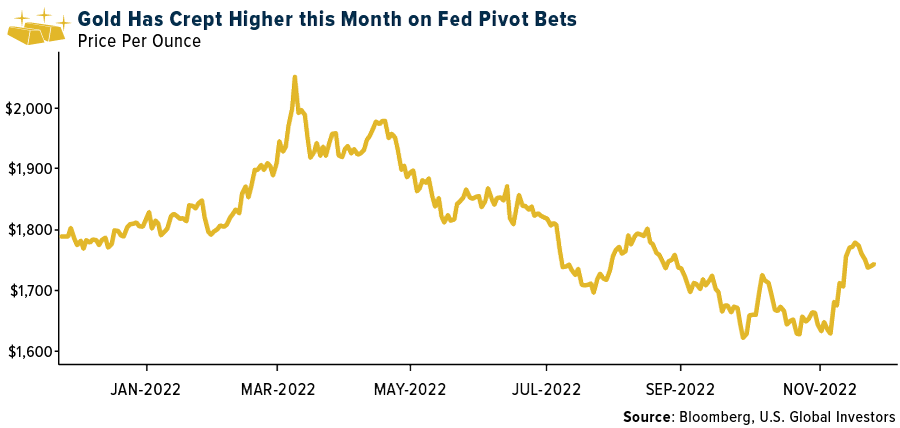Strengths

- The best performing precious metal for the week was silver, up 2.02% largely on improved sentiment across the precious metals space, except for palladium, with the Fed Minutes indicating a more moderate interest rate path ahead.
- This week, UBS identified three structural reasons in favor of gold:
1) Long-term investors and the official sector are gradually building gold allocations. Central banks have been net buyers of gold for more than a decade now, amid a broader trend of diversifying dollar-denominated reserves. This year, the Russia-Ukraine war and corresponding sanctions reinforced this theme. Net official sector buying to 3Q22 is already higher than previous full-year highs.
2) The proportion of gold holdings relative to overall assets held by institutional investors remains light, in their view, and they think it is likely held more for diversification and portfolio protection rather than expectations of outright material price appreciation. This implies more resilient core positions and scope for allocations to grow.
3) Strong physical demand has also been a key factor affecting the relationship between gold and real rates, in their view. Key physical gold markets India and China have continued to buy large volumes of gold this year, helped by cheaper prices as gold came under pressure from macro forces.
Weaknesses
- The worst performing precious metal for the week was palladium, down 6.47% on little specific news. Harmony Gold’s first fiscal quarter gold produced is down 1%, but gold sold is up 4% and mining revenue is up 5%. Following the restructure of Tshepong, Harmony comments that Tshepong North & South have performed well, due to better recovered grades. Load curtailment has had a negative impact on first-quarter production, resulting in 3,200 ounces lost production. All-in sustaining costs (AISC) of $1,657 per ounce are 2% down year-over-year and 4% down quarter-over-quarter, but 8% up above consensus.
- The Australian Broadcasting Commission (ABC) reported that Cadia gold mine's expansion approval was revoked after it failed an air quality audit. Newcrest’s proposed Cadia expansion to 35 million tons per annum (mtpa) from 32 mtpa was approved in December 2021 subject to conditions. ABC reports the independent audit returned findings in October that included one vent shaft was emitting 18 times what is legislated as safe amounts of carcinogen respirable crystalline silica. A second vent also exceeded limits.
- The government of Ghana let creditors know they should expect a 30% haircut on its outstanding bonds as it attempts to negotiate a new rescue package with the International Monetary Fund (IMF). Consequently, all gold miners, such as Newmont, AngloGold Ashanti and Gold Fields, must sell 20% of their gold production to the nation’s central bank which will use the gold to purchase oil for the country.
Opportunities
- Lucara Diamond announced that it’s extended its sales agreement with Belgium-based HB Trading BV (HB) for another 10 years, for the sale of its gem quality rough diamonds from the Karowe mine. This integrated approach de-risks any cash flow uncertainty from the sale of high-value diamonds and allows for potential revenue upside through polished price participation. The HB agreement has accounted for 60-70% of Lucara’s total revenue since first partnering in 2020.
- Bloomberg recently interviewed Nouriel Roubini with a view to where investors should park some money for the next decade. Roubini noted the current problems of inflation, geopolitical and environmental risk suggest one, very short adjustable-rate Treasuries, secondly own some Treasury Inflation-Protected Security (TIPS) because inflation expectations have not yet de-anchored and third, go back into gold and precious metals. He pointed out China has trillions of dollars in reserves in dollars that it is likely to move to other assets that can’t be sanctioned or seized by the U.S. or Europe.
- UBS has updated its near-term gold price forecast in line with the more bullish view from its Strategy team, which is now looking for the Federal Reserve to cut from 5% to 3.25% by the end of 2023, pushing gold to $1,900 per ounce.
Threats
- At its investor day, Barrick Gold highlighted in detail its strategy of creating a long-term, sustainable business with growth and exploration optionality. It provided an updated five-year outlook indicating gold production growth through 2027. Forecast gold cash costs have increased in 2023 given current global inflationary pressures, but then fall over time given higher production and the assumption of easing inflationary pressures
- There have been guidance revisions and cautious commentary from peers through 2022, and the market response suggested a belief that Barrick was immune from many of the inflationary pressures and production challenges affecting the rest of the market. Barrick provided rough revised five- and ten-year guidance at its investor day which showed some of the same impacts to Barrick in 2023 and going forward.
- Barrick’s plans indicated 2023 attributable capex of around $2.6 billion, up from $2.3 billion in 2022 and above consensus of $2 billion. Part of the increase is from the Pueblo Viejo (60% Barrick, 40% Newmont) expansion and new tailings facility that is now expected to cost $2.1 billion (100% basis), up from $1.4 billion previously.

